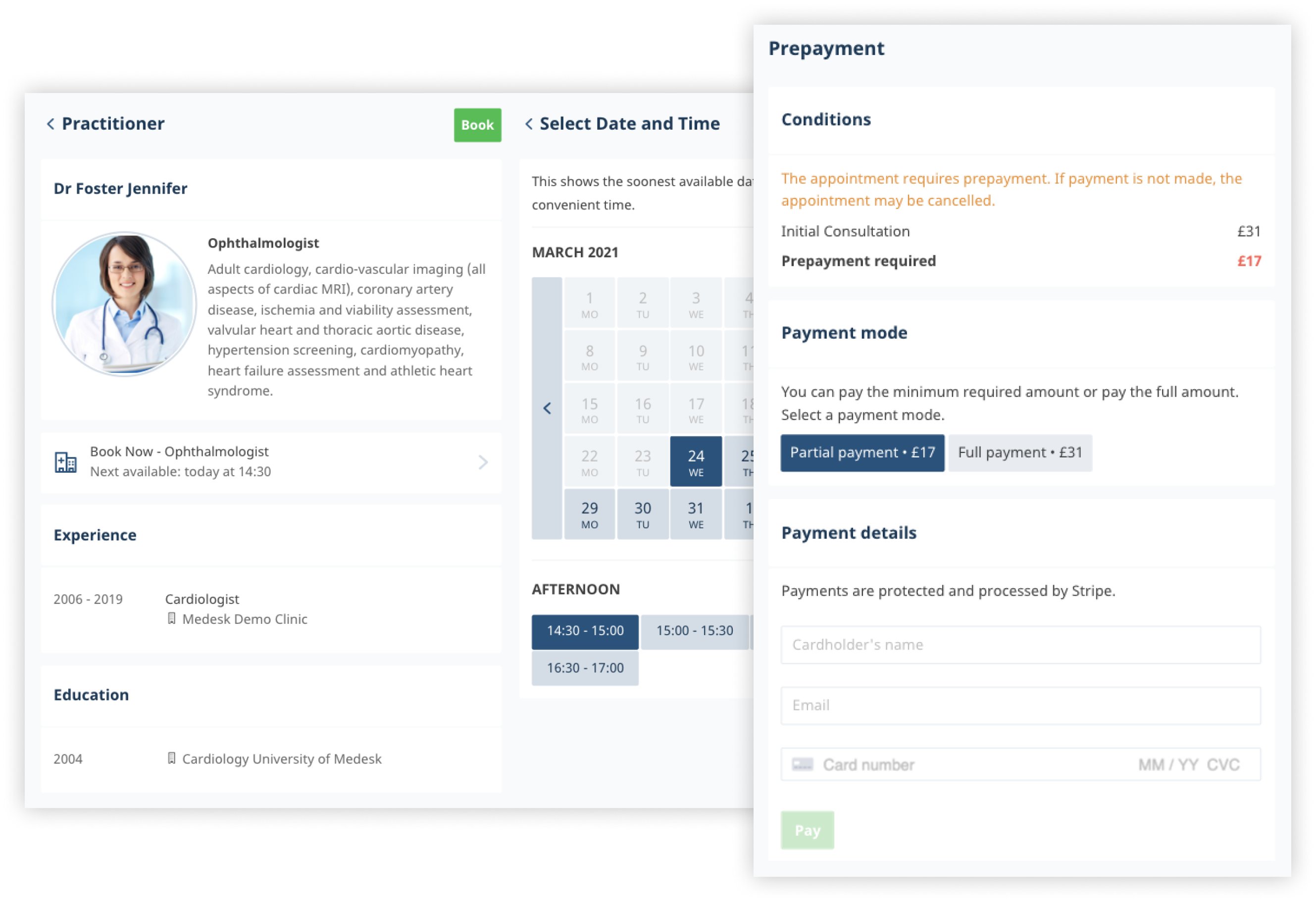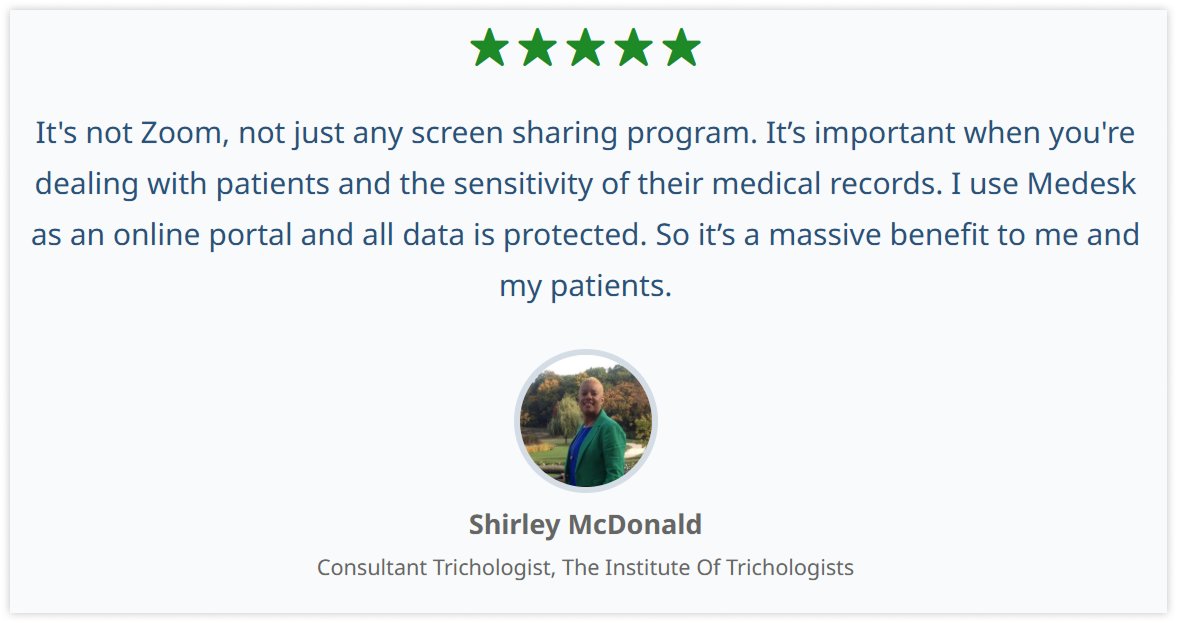Think telehealth is too expensive for your practice? Think again.
The truth is, not adopting telehealth software might be costing you more than implementing it. With Medicare expanding coverage, patients demanding virtual care, and hospitals saving millions by reducing readmissions, telehealth business isn’t just a trend—it’s a smart financial move.
But how much does it really cost to get started? And how can you avoid overpaying for features you don’t need?
Let’s break it down—no fluff, just real numbers and practical advice.
Learn how to simplify your practice workflow and free up more time for patients with Medesk.
Open the detailed description >>The Real Costs of Telemedicine: What You’re Actually Paying For
1. Technology setup
What’s the cost? $10,000–$100,000, depending on your setup. This includes healthcare software, cameras, microphones, and integration with your electronic health record (EHR) system.
Some vendors push expensive medical devices or proprietary tablets, but most practices only need:
- Basic tablets/laptops (iOS or Android) for video conferencing.
- Reliable internet (no enterprise-grade upgrades required).
- Secure data storage.
With Medesk, you get a subscription-based telehealth platform that integrates with your EHR and practice management system (PMS) for a fraction of the cost. You work on existing devices and avoid unnecessary hardware investments. If you want to launch under your own brand without building from scratch, a white label telehealth platform enables rapid go-to-market, full branding control, and seamless EHR/PMS integrations.
2. Implementation: getting it up and running
When evaluating telemedicine software solutions, healthcare providers typically encounter three main pricing models:
Subscription-Based Telemedicine Platforms:
- Monthly or annual fees ranging from $50 per user.
- Typically include core functionality like video consultations.
- Often have tiered pricing based on features and scale.
Pay-Per-Use Models:
- Charge per consultation.
- May have minimum monthly commitments.
- Can become expensive for high-volume practices.
Enterprise Custom Solutions:
- 200,000+ for custom development.
- Requires significant in-house IT resources.
- Ongoing maintenance costs (15-20% of initial cost annually).
We bundle telehealth into our core offering, so you skip separate implementation fees. Medesk’s plug-and-play setup means you’re live in 8 days, not months.
Medesk helps automate scheduling and record-keeping, allowing you to recreate an individual approach to each patient, providing them with maximum attention.
Learn more >>3. Staff training
What’s the cost? $1,000–$10,000, depending on team size.
The human element of telehealth implementation often gets overlooked in cost analyses. Consider these factors:
Training requirements:
- Get to know the platform (2-4 hours per staff member).
- Adopt the new workflow (1-2 weeks adjustment period).
- Ongoing support and refresher training.
And don't forget that while you're getting used to the new software, you may be seeing fewer patients or having technical closures to review documentation and educate patients.
4. Keeping up with the regulatory compliance
In the U.S., Centers for Medicare & Medicaid Services (CMS) regulations, state licensing fees and laws, and evolving Medicare coverage policies directly impact the overall cost of telehealth implementation.
Each year, CMS sets the reimbursement framework for telehealth, directly affecting:
- Which healthcare services are billable
- What technology is required
- Documentation standards
For example, Medicare requires real-time, interactive audio-video for most telehealth visits (except certain mental health and audio-only services). It means providers must invest in HIPAA-compliant video platforms (about $150/user/month) instead of free tools like Zoom. If software isn’t properly certified, claims get denied, wasting staff time on appeals.
The Chronic Care Management (CCM) program under Medicare (CPT 99490) reimburses providers ~$62 per patient per month for managing patients with 2+ chronic conditions. However, strict CMS rules govern billing, creating both cost challenges and opportunities.
For example, nurses or care coordinators must spend at least 20 minutes/month per patient on medication management or care plan updates. If done manually, the staff spend 3–5 hours per week logging time, leading to $25,000/year in labor costs for a mid-sized practice. Similar is the case with RTM (Remote Therapeutic Monitoring), which allows billing for non-physiologic data.
And here is another example concerning RPM. Medicare only pays for RPM (CPT 99453-99458) if:
- Devices are FDA-cleared (no consumer wearables like Fitbit).
- Data is collected 16+ days/month.
- Providers spend 20+ mins/month reviewing patient data.
If you fail to comply with these rules, you’ll get rejected claims with $200 lost per patient per month and 1-2 extra staff hours per week for manual claim tracking.
Let’s not forget about state licensing & interstate practice laws. Telehealth often crosses state lines—triggering complex (and costly) licensing requirements.
A provider in New York seeing a patient in New Jersey needs both state licenses, costing him $1,500 per state. Some states (e.g., Texas, Florida) require additional telehealth registrations ($500/provider/year).
HIPAA compliance is non-negotiable, yet many telehealth solutions cut corners, risking:
- Fines up to $50,000 per violation.
- Data breaches (patient information leaks = lost trust + lawsuits).
- Rejected Medicare claims (if billing codes aren’t updated).
Compliant vs. Non-Compliant Telehealth
| Expense Category | Cutting Corners | Fully Compliant |
|---|---|---|
| Video Platform | Free Zoom ($0) | $32/month (HIPAA-compliant) |
| RPM Devices | Fitbit ($150, non-reimbursable) | FDA-cleared ($300, Medicare-covered) |
| State Licensing | Risk fines ($5k/violation) | Properly licensed ($500/provider) |
| HIPAA Security | Potential breach ($9M risk) | Built-in compliance ($0 extra) |
| Claim Denials | 20% rejection rate ($50k lost) | Auto-coded billing ($0 lost) |
How to Minimize Telemedicine Business Compliance Costs
- Never use consumer apps (Zoom, WhatsApp) – the fines outweigh the savings.
- Automate RPM/CCM documentation to prevent Medicare claim denials.
- Track state licenses digitally to avoid $5k+ penalties.
- Choose all-in-one platforms that bundle compliance features.

5 Ways Telemedicine Pays for Itself and Fills Up Your Schedule
Let’s face it: healthcare is expensive, and every dollar counts. For providers, the fear of sinking money into a new system and failing is real. But here’s the flip side: telehealth can slash costs and improve patient care.
A study from Health Recovery Solutions found that telehealth visits cost $40–$50 compared to $136–$176 for in-person visits. That’s up to $126 saved per visit. Multiply that by hundreds of patients, and you’re looking at serious savings.
So, why should you care? Because telehealth isn’t just about keeping up with trends—it’s about staying competitive, reducing hospital readmissions, and tapping into new revenue streams like remote patient monitoring (RPM).
Here’s a detailed breakdown of how virtual care boosts revenue, reduces costs, and enhances patient outcomes.
1. Slashing hospital readmissions (saving $15,000+ per patient)
Hospital readmissions are a massive financial drain on healthcare systems. The average cost of a 30-day readmission ranges from $25,000, depending on the condition. Medicare penalizes hospitals with excessive readmission rates, cutting reimbursements by up to 3%.
Emergency room avoidance represents another major area of savings. Studies show that 38% of ER visits for chronic disease patients can be safely redirected through telehealth triage services, converting 3,000 emergency encounters into $150 virtual consultations.
This not only reduces immediate costs but also alleviates strain on overcrowded emergency departments.
How telehealth solves this:
- RPM tracks high-risk patients post-discharge, flagging complications before they escalate.
- Chronic care management via telehealth reduces avoidable readmissions by 50%+ (CMS data).
- Automated alerts notify providers of abnormal vitals (e.g., blood pressure spikes in heart failure patients).
For heart failure patients—where 30-day readmissions carry both clinical and financial penalties—remote patient monitoring coupled with daily virtual check-ins has demonstrated a 42-50% reduction in readmission rates.
Discover more about the essential features of Medesk and claim your free access today!
Explore now >>2. Cutting the length of inpatient stays
Telehealth helps shorten hospital stays, saving time and resources. With virtual care and remote patient monitoring, hospitals can discharge patients sooner while still keeping a close eye on their recovery through video consultations.
A 2023 study found that telehealth services cut postoperative hospital stays by 22%, freeing up beds faster without sacrificing patient care quality.
3. Boosting revenue through Medicare & private payer reimbursements
Medicare and private insurers now actively reimburse for telehealth services, creating new revenue streams.
Key billable telehealth services include:
| CPT Code | Service | Reimbursement |
|---|---|---|
| 99453 | RPM setup & patient education | $20–50 |
| 99457 | RPM monitoring (20+ mins/month) | $50–100 |
| 99458 | Additional RPM time (each 20 mins) | $+40–60 |
| G2012 | Virtual check-ins | $15–25 |
| 99212-99215 | Established patient e-visits | $50–150 |
CMS reimburses for remote patient monitoring (CPT 99453, 99454) and chronic care management (CPT 99490), adding thousands monthly. A mid-sized practice monitoring 50 chronic care patients with RPM can generate:
- $2,500/month (99453 + 99457)
- $30,000/year in new recurring revenue
- Adding 20 virtual follow-ups/week at 78,000/year.
4. Improving patient experience
Telehealth makes life easier for patients by removing common obstacles. No more long trips or time off work for in-person visits, which is a game-changer for elderly, disabled, or rural patients.
For those with serious health issues, telemedicine services keep them connected to their healthcare professionals. Patients can share health updates or symptoms in real-time, so problems get caught early. This constant link shifts care from reacting to issues to preventing them, giving patients peace of mind.
Telehealth also improves patient-provider communication. Patients can message securely to clear up instructions or access educational resources anytime. This builds confidence, helping them take charge of their health between visits.
Our user-friendly telehealth app for iOS and Android streamlines appointment scheduling, boosting patient care and filling your calendar. Practices using Medesk report a 20% increase in appointments, per our case studies.

5. Cutting No-Shows by 30%+ (Recovering Lost Revenue)
The average no-show rate in healthcare is 15–30%, costing practices 200 per missed appointment. For a 5-provider clinic, that’s $150,000+ in lost revenue annually.
When patients receive automated reminders and start the appointments from home or work, it increases adherence, eliminates commute barriers and reduces forgetfulness.
For example, Cleveland Clinic reported a 30% drop in no-shows after implementing telehealth.
Care Costs Without vs. With Telehealth
| Care Site | Utilization (%) | Cost Without Telehealth | Cost With Telehealth |
|---|---|---|---|
| Urgent Care | 45.8 | $98–$169 | $40–$50 |
| Emergency Room | 5.6 | $943–$1,595 | $40–$50 |
| Physician Office | 30.9 | $83–$95 | $40–$50 |
| Other Clinics | 5.4 | $83–$578 | $40–$50 |
When comparing costs to revenue, a mid-sized practice could recoup initial investments within months while generating $78,000+/year from virtual follow-ups alone. Telehealth isn’t just an expense—it’s a profit-driving tool that enhances patient care and practice sustainability.
By focusing on long-term financial gains—not just upfront costs—you can maximize ROI while avoiding unnecessary overhead.
Why Wait to Boost Revenue?
Worried about telemedicine startup costs? With Medesk, the initial investment is minimal, and the revenue potential is huge:
- No upfront telemedicine app development costs. Medesk’s scalable subscription includes video conferencing, remote patient monitoring, and EHR integration.
- Our telehealth app for iOS and Android is so simple that your team will love it, improving user experience.
- Cybersecurity and data security protect patient information, meeting healthcare regulations.
- From appointment scheduling to chronic care management, Medesk grows with your user base.

Start with our free trial to see how telemedicine solutions drive profits through a fully booked schedule.


